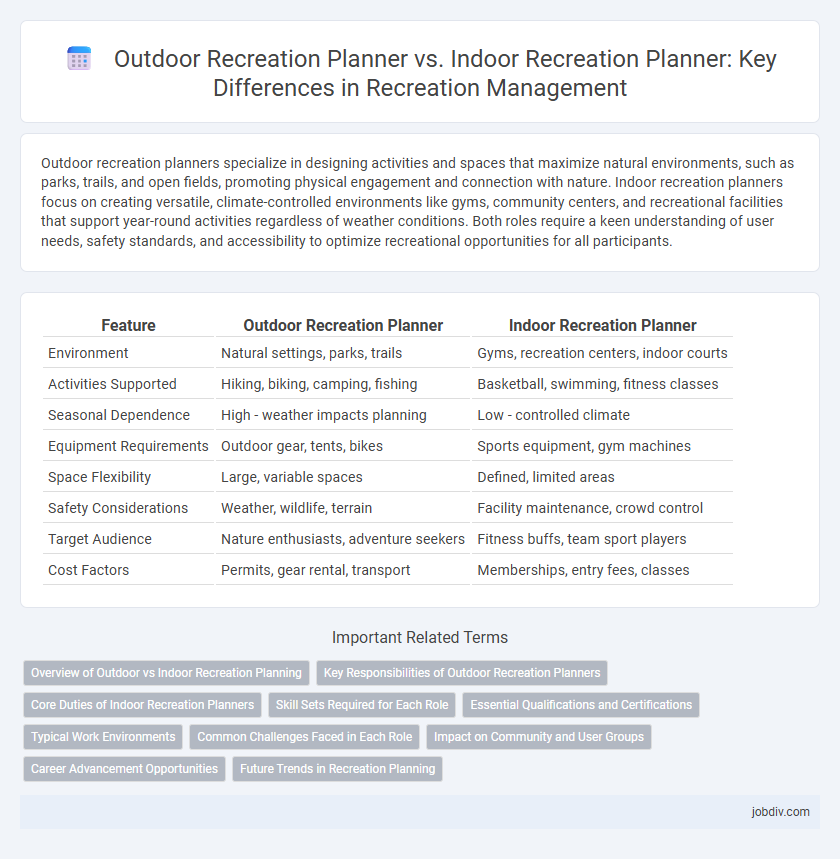Outdoor recreation planners specialize in designing activities and spaces that maximize natural environments, such as parks, trails, and open fields, promoting physical engagement and connection with nature. Indoor recreation planners focus on creating versatile, climate-controlled environments like gyms, community centers, and recreational facilities that support year-round activities regardless of weather conditions. Both roles require a keen understanding of user needs, safety standards, and accessibility to optimize recreational opportunities for all participants.
Table of Comparison
| Feature | Outdoor Recreation Planner | Indoor Recreation Planner |
|---|---|---|
| Environment | Natural settings, parks, trails | Gyms, recreation centers, indoor courts |
| Activities Supported | Hiking, biking, camping, fishing | Basketball, swimming, fitness classes |
| Seasonal Dependence | High - weather impacts planning | Low - controlled climate |
| Equipment Requirements | Outdoor gear, tents, bikes | Sports equipment, gym machines |
| Space Flexibility | Large, variable spaces | Defined, limited areas |
| Safety Considerations | Weather, wildlife, terrain | Facility maintenance, crowd control |
| Target Audience | Nature enthusiasts, adventure seekers | Fitness buffs, team sport players |
| Cost Factors | Permits, gear rental, transport | Memberships, entry fees, classes |
Overview of Outdoor vs Indoor Recreation Planning
Outdoor recreation planners focus on designing activities and facilities such as hiking trails, picnic areas, and sports fields that leverage natural landscapes and seasonal variations. Indoor recreation planners develop spaces like gymnasiums, swimming pools, and entertainment centers, emphasizing controlled environments and year-round accessibility. Both roles require understanding user demographics and safety standards but differ significantly in environmental considerations and infrastructure requirements.
Key Responsibilities of Outdoor Recreation Planners
Outdoor Recreation Planners assess natural landscapes to develop sustainable recreational areas that balance environmental preservation with public access and enjoyment. They conduct site analysis, manage land use permits, and design trail systems, campgrounds, and picnic areas that promote outdoor activities such as hiking, fishing, and camping. Collaborating with environmental scientists, government agencies, and local communities is essential to ensure compliance with conservation regulations and to enhance the outdoor experience.
Core Duties of Indoor Recreation Planners
Indoor Recreation Planners focus on designing, organizing, and managing activities and facilities that cater to indoor environments such as gyms, community centers, and indoor sports complexes. Their core duties include assessing space utilization, coordinating safety protocols, and selecting appropriate equipment to enhance user experience within enclosed settings. They work closely with architects, program coordinators, and maintenance teams to ensure functional, accessible, and engaging recreational spaces year-round.
Skill Sets Required for Each Role
Outdoor Recreation Planners require expertise in environmental assessment, land use management, and risk evaluation to design activities that align with natural settings and safety regulations. Indoor Recreation Planners need skills in facility management, spatial design, and equipment maintenance to create engaging and accessible activities within controlled environments. Both roles demand strong communication, project management, and community engagement abilities to effectively plan and implement recreational programs.
Essential Qualifications and Certifications
Outdoor Recreation Planners require certifications such as Certified Park and Recreation Professional (CPRP) and expertise in environmental science or natural resource management. Indoor Recreation Planners often hold qualifications in facility management and certifications like Certified Recreation Facility Professional (CRFP). Both roles demand strong skills in program development, safety regulations, and community engagement to design effective recreational activities and spaces.
Typical Work Environments
Outdoor Recreation Planners typically work in natural settings such as parks, forests, and wilderness areas, collaborating with environmental scientists and park rangers to design sustainable recreational activities. Indoor Recreation Planners operate in community centers, gyms, and recreational facilities, coordinating programs that accommodate urban populations and diverse age groups. Both roles require knowledge of safety regulations and user engagement strategies tailored to their specific environments.
Common Challenges Faced in Each Role
Outdoor recreation planners often contend with unpredictable weather conditions, environmental regulations, and the need for sustainable resource management to protect natural habitats. In contrast, indoor recreation planners face challenges related to space optimization, facility maintenance, and creating engaging environments that accommodate diverse user groups year-round. Both roles require balancing budget constraints and stakeholder interests while designing accessible and safe recreational programs.
Impact on Community and User Groups
Outdoor recreation planners enhance community well-being by designing parks, trails, and natural spaces that promote physical activity, social interaction, and environmental education for diverse user groups. They prioritize sustainable land use and accessibility to support activities like hiking, biking, and wildlife observation, benefiting families, fitness enthusiasts, and conservationists. Indoor recreation planners focus on creating versatile facilities such as gyms, community centers, and sports complexes that accommodate year-round activities, providing safe, weather-independent environments for youth programs, senior citizens, and organized sports leagues.
Career Advancement Opportunities
Outdoor Recreation Planners often have greater career advancement opportunities due to the expanding demand for sustainable tourism and park management, leveraging expertise in environmental conservation and land use planning. Indoor Recreation Planners specialize in designing community centers and sports facilities, which offers steady growth tied to urban development and public health initiatives. Both career paths benefit from certifications and advanced degrees, but outdoor roles may provide wider opportunities in federal agencies and large-scale project management.
Future Trends in Recreation Planning
Outdoor recreation planners are increasingly integrating smart technology and environmental sustainability to design adaptive trails, parks, and adventure spaces that cater to growing eco-conscious user demands. Indoor recreation planners focus on creating versatile, tech-enabled facilities with virtual reality zones and modular spaces that accommodate year-round activities and diverse user groups. Both roles emphasize data-driven decision-making and community engagement to respond to shifting demographics and enhance overall recreational experiences.
Outdoor Recreation Planner vs Indoor Recreation Planner Infographic

 jobdiv.com
jobdiv.com